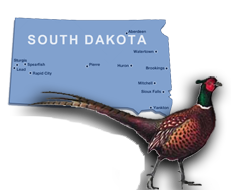Recipe - Turpheasant (Unique)
Turpheasant
Have you heard of Turducken? It is a deboned Chicken, with stuffing around it, surrounded by a deboned Duck, again with stuffing outside, wrapped in a deboned Turkey. It is several layers of meat, separated by layers of stuffing (it is all deboned before cooking).
If you are cooking a turkey for Thanksgiving or for Christmas Holidays, you should try the Turpheasant. The difference is we leave the bones in, and just put the whole pheasant inside the turkey (with-out stuffing). We also recommend cooking it on the grill. You can make your stuffing separate, and use any stuffing that you like, our favorite is the cornbread stuffing, and there are lots of good recipes for cornbread stuffing (cooking outside the bird).
You can just put the thawed out pheasant right inside the turkey. Normally, a pheasant is so small compared to a Turkey that it fits easily. Optionally, you can put some stuffing in the Pheasant, then you can slide the pheasant in, on top of a small layer of stuffing, which gives a little flavor. The pheasant will cook in the warm moist inner cavity, and will cook for a long time, which is required for making it tender.
Food safety warning (for Turkey stuffing): Many people stuff their turkeys, but then just measure the temperature of the turkey to verify it is at 165 degrees, and that it is done. But, the inside cavity will take longer to get warm, and you must get the stuffing to 165 degrees to kill any bacteria. When you stuff the Turkey, the stuffing is touching the bird, hence the bacteria are on the stuffing, and the inside will not get warm for quite a while. Alway prepare your turkey immediately before putting it in the oven (not the night before). If you prepare then put it in the refrigerator, the inside may not stay cold, due to the thickness of the bird (causing food illness problems).
If you are cooking Turpheasant, you will want to make sure the pheasant meat is 165 degrees or more (before serving).
Notes for cooking on the grill
You will want a larger grill, or a smaller Turkey (so it fits on the inner part of the grill). The idea is to provide indirect heat to the grill. I like my Brinkman grill, as there is plenty of space, the burners go front to back so I can use the space in the middle of the grill, and have the heat on the outside. But, there are lots of good brands and grills.
Buy a short flat tin foil pan, and or buy a larger sided flat pan and fold down the sides, so that you can fit the flat pan underneath the grill plates. You only need 1/2 to 1" of depth in the pan. The Turpheasant will cook on top of the grill plates, the juices will drop down into the pan, and then continue to evaporate up into the grill, to keep the bird moist.
Process for making Turpheasant:
Thaw out the turkey and pheasant, then slide in the pheasant, and then fill the cavity with carrots, celery, garlic and other vegetables that you enjoy.
Put 1/2 cup of water into the pan, or dump in a bottle of Michelob beer, or any seasonings you might like.
Place the Turpheasant on the grill, then cover the Turpheasant with tin foil, cover the breast, and wrap the legs. The tin foil will help to keep the moisture in the Turpheasant. You do not wrap the back side of the Turpheasant (which is touching the gill), just wrap the top.
On the grill, you need to have a higher temperature than in the oven. Keep the grill at a constant temperature above 400 degrees, with a goal of 425 degrees.
We have found that cooking on the grill is much faster than cooking in the oven, and it works well in the winter as well as summer. If it is Christmas or Thanksgiving, you will want your grill to be out of the wind, but other than that, it has always heated up well.
You will need a meat thermometer. Cook the meat to 165 degrees minimum. Once the outside is finished, allow another hour to finish the inside (the pheasant). Or, if you feel it is done, be sure to make sure the pheasant has reached a temperature of 165 degrees. See the danger note, many people only measure the turkey temperature, and don't cook their stuffing enough, be sure the pheasant is fully cooked.
Our last Turkey ended up at 195 degrees, and I was very concerned that I ruined it, but it turned out to be the best turkey we ever had. Be sure to cook until all the meat is at least 165 degrees.
Serve with all your other holiday dishes!

